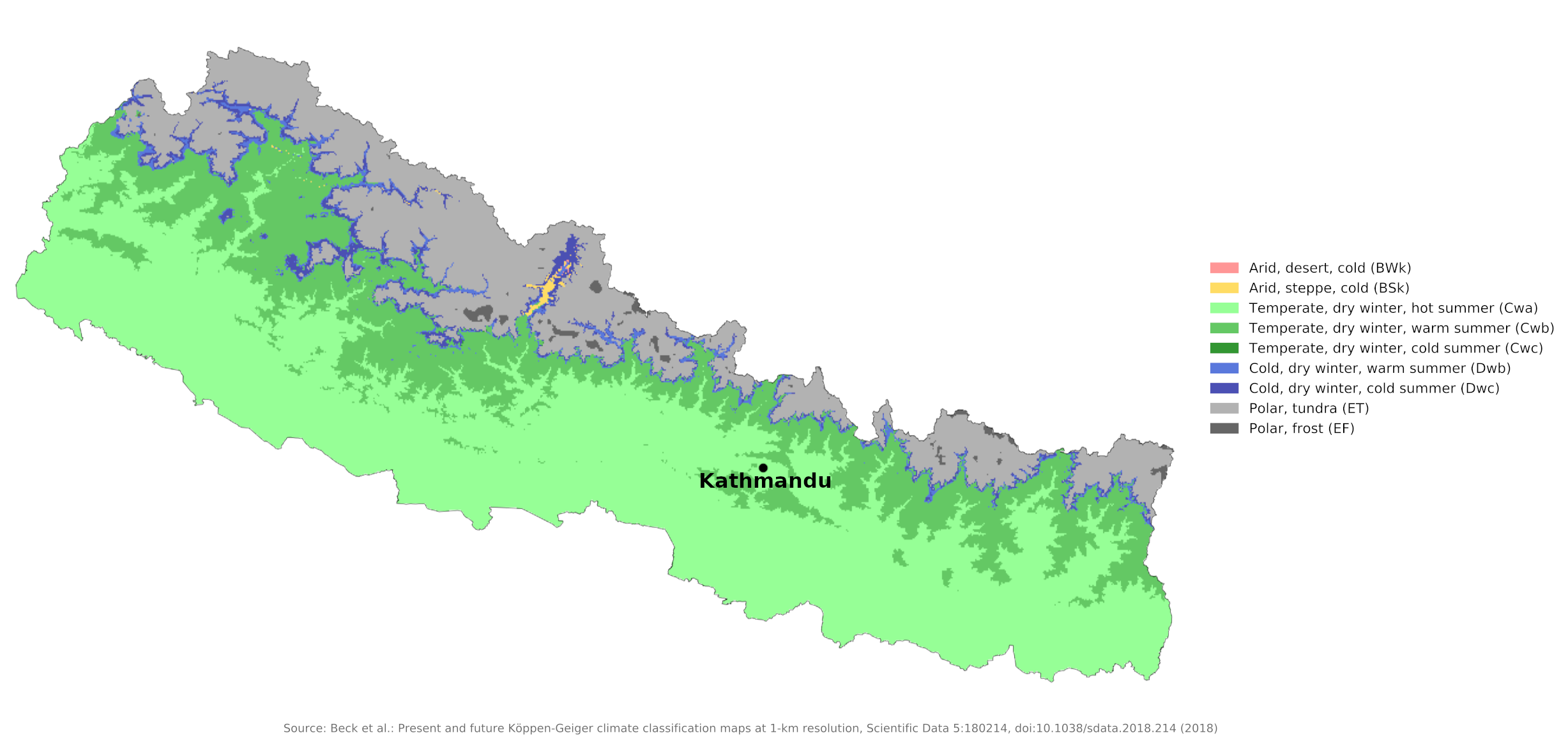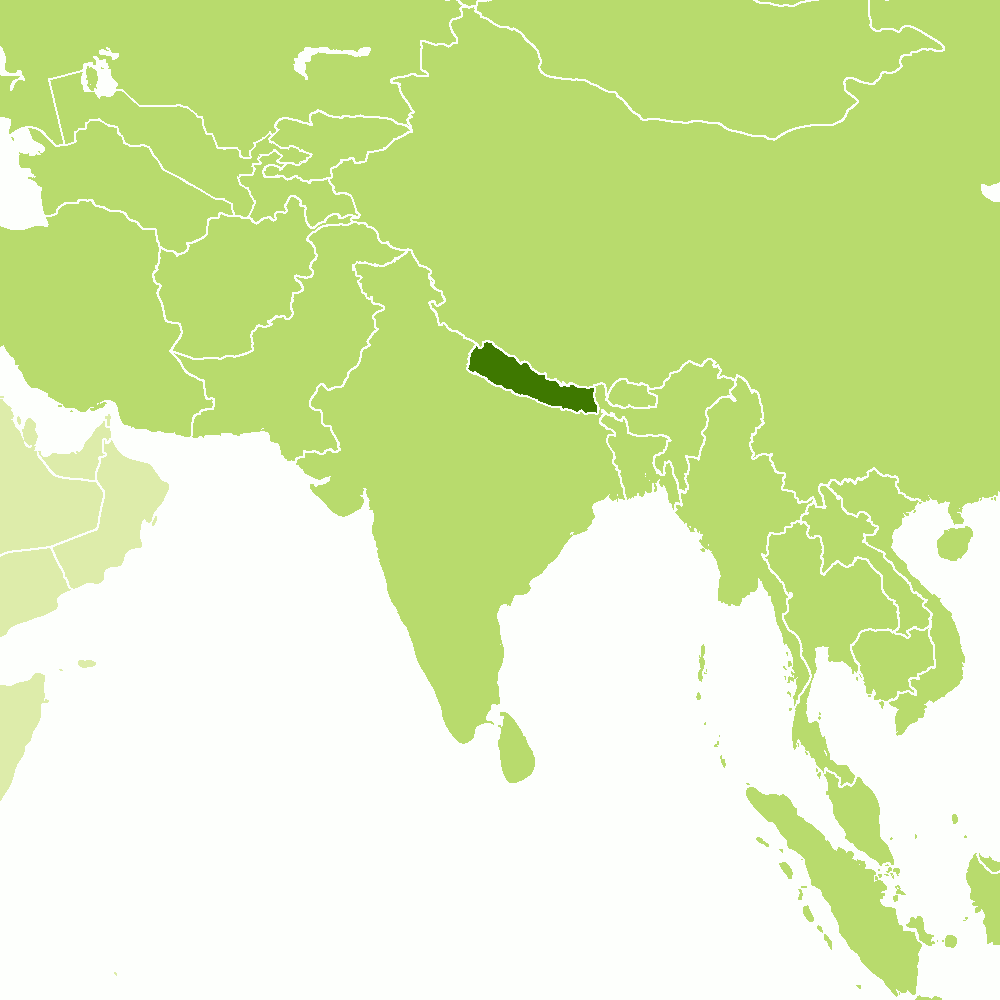The Climate of
Nepal
 Taal Barahi Temple, on a small island in Pokhara
Taal Barahi Temple, on a small island in Pokhara
Climate Map
 Climate map of the Nepal
Climate map of the Nepal
What is the climate of Nepal like?
Nepal is a small, mountainous country on the southern side of the Himalayan Mountains between Tibet to the north and India to the south. It includes within, or along its northern border, some of the highest mountains in the world; Everest rises to 8,849 meters (29,031 feet). The country is only between 160 and 240 km (100–150 miles) wide from north to south, and in this distance the altitude decreases from the high Himalayan peaks to the lowlands of the Terai in the plain region of northern India. There is thus in Nepal a range of climatic conditions from tropical forest or jungle to the permanent snowfields and glaciers of the Himalayas.
The weather and climate are controlled by the same general features as India: the seasonal alternation of the monsoon winds. The main rainy season in Nepal is from late June to September. This is a period of warm to hot temperatures, much cloud, and frequent heavy rain. At this time sunshine averages only two to three hours a day. During the rest of the year the weather is much more settled and pleasant. The days are mild or even warm, except on the higher mountains, and sunshine averages from six to nine hours a day.
Below the Kathmandu Valley and throughout the Terai lowland, the climate is subtropical and, in the swamps and forests, extremely humid. The valley itself enjoys the temperate conditions generally found between altitudes of 1,200 and 3,400 meters (4,000–11,000 feet). At 1,300 meters (4,300 feet) above sea level, the elevation of Kathmandu, the rainy season lasts from June to October; 80% of annual precipitation falls during this monsoon season. Colder weather follows, lasting until the middle of March, when the warm season begins. The warm season increases in intensity until broken by the rains, which account for precipitation of about 1,500 millimeters (60 inches) annually. Rainfall in Nepal decreases from east to west. Temperatures in Kathmandu in January range from an average minimum of 2°C (36°F) to an average maximum of 18°C (64°F); the July range is 20–29°C (68–84°F).
Northward of the Kathmandu Valley, a subalpine zone continues to altitudes of about 4,300 meters (14,000 feet); above that elevation, the country is covered with snow during the long winter. Above 4,900 meters (16,000 feet), the temperature stays below freezing, and there is permanent snow and ice, and extreme cold is experienced in the upper Himalayas.
| Climate data for Kathmandu (1981–2010) | |||||||||||||
|---|---|---|---|---|---|---|---|---|---|---|---|---|---|
| Month | Jan | Feb | Mar | Apr | May | Jun | Jul | Aug | Sep | Oct | Nov | Dec | Year |
| Average high °C (°F) | 19.1 (66.4) | 21.4 (70.5) | 25.3 (77.5) | 28.2 (82.8) | 28.7 (83.7) | 29.1 (84.4) | 28.4 (83.1) | 28.7 (83.7) | 28.1 (82.6) | 26.8 (80.2) | 23.6 (74.5) | 20.2 (68.4) | 25.6 (78.1) |
| Daily mean °C (°F) | 10.8 (51.4) | 13.0 (55.4) | 16.7 (62.1) | 19.9 (67.8) | 22.2 (72.0) | 24.1 (75.4) | 24.3 (75.7) | 24.3 (75.7) | 23.3 (73.9) | 20.1 (68.2) | 15.7 (60.3) | 12.0 (53.6) | 18.9 (66.0) |
| Average low °C (°F) | 2.4 (36.3) | 4.5 (40.1) | 8.2 (46.8) | 11.7 (53.1) | 15.7 (60.3) | 19.1 (66.4) | 20.2 (68.4) | 20.0 (68.0) | 18.5 (65.3) | 13.4 (56.1) | 7.8 (46.0) | 3.7 (38.7) | 12.1 (53.8) |
| Average precipitation mm (inches) | 14.4 (0.57) | 18.7 (0.74) | 34.2 (1.35) | 61.0 (2.40) | 123.6 (4.87) | 236.3 (9.30) | 363.4 (14.31) | 330.8 (13.02) | 199.8 (7.87) | 51.2 (2.02) | 8.3 (0.33) | 13.2 (0.52) | 1,454.9 (57.28) |
| Source: Department of Hydrology and Meteorology | |||||||||||||
The towering Himalayas play a crucial role in blocking the northwestern advances of humid, tropical air from the Bay of Bengal, ultimately causing it to turn to rain in summer. In winter, this area prevents cold air blows from inner Asia from reaching southern Nepal and northern India, resulting in warmer winters in these regions than would otherwise be the case.
The summer monsoon is a strong flow of humid air from the southwest. Although the arrival of the summer monsoon can vary by up to a month, it generally arrives in Nepal in early June, is preceded by violent lightning and thunderstorms, and lasts until September when it begins to recede. The plains and lower Himalayas receive more than 70 percent of their annual rainfall during the summer monsoon. The amount of summer monsoon rain generally decreases from the southeast to the northwest as the maritime air wedge gradually becomes thinner and drier. It regularly causes landslides and severe flooding on the plains. Conversely, prolonged interruptions in the summer monsoon can result in severe drought.
The monsoon retreats into mid-October, making for generally cool, clear, and dry weather. By this time, the harvest is complete and people are in a festive mood. The two largest and most important Hindu festivals—Dashain and Tihar (Diwali)—take place during this period.
In December comes the winter monsoon, a strong north-easterly current characterized by occasional, brief rains on the lowlands and plains and snowfalls on the highlands. The amount of precipitation resulting from the northeast land trade winds increases with altitude. This winter precipitation in the form of snow in the Himalayas is important for the production of the spring and summer melt water, which is crucial for the rivers.
References
- E. A. Pearce, Charles Gordon Smith, (1990) The Hutchinson World Weather Guide, John Murray Press. ISBN 1859863426
- Timothy L. Gall, (ed.), (2003), Worldmark Encyclopedia of the Nations, Eleventh Edition, Thomson Gale
- Federal Research Division, Library of Congress, (1993), Nepal and Bhutan: country studies. Claitor's Pub. Division. ISBN 0844407771
- Hugh Chisholm, (ed.), (1911), Encyclopædia Britannica, Eleventh edition, Cambridge University Press
The Climate of
Nepal

In summary:
The climate of Nepal ranges from subtropical in the south to the permanent snowfields of the Himalayas in the north. Generally the country has a subtropical highland climate with four distinct seasons.
Most of Nepal’s rainfall happens during the summer monsoon season from June to September.